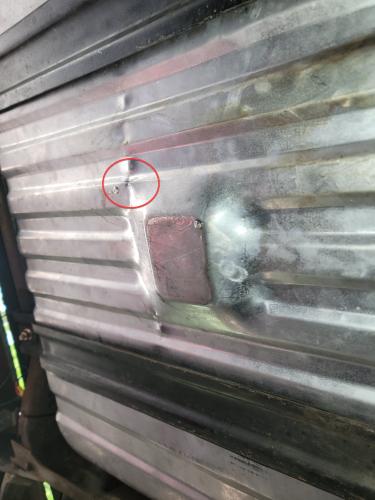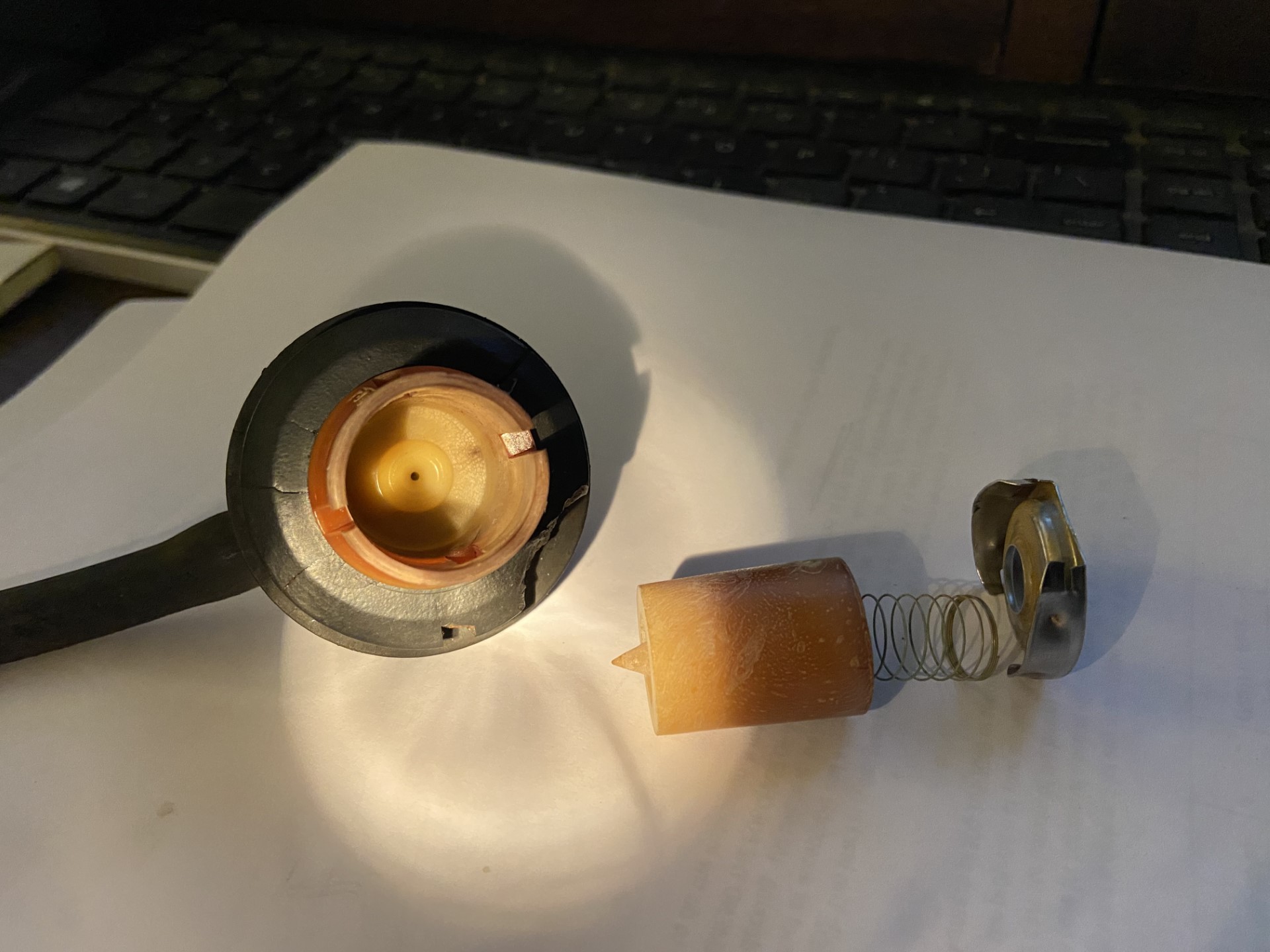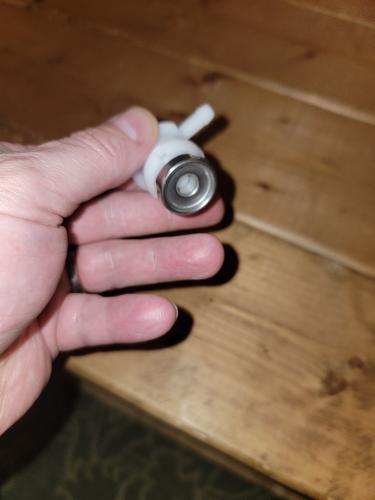Fuel tank rupture caused by negative pressure????
Fuel tank rupture caused by negative pressure????
|
Hey everyone... Happy 4th week/weekend.
I've got a good one. 1985 F150 2wd, 5.0L EFI, dual tanks. New fuel lines, new gas tanks/pumps/sending units. Also has new vents in the top of the tank. I have converted the fuel filler neck to the 1987 version for easier fill-ups and thus has a 1987 vented cap. The rear tank started to leak under the spare tire. Once the spare was out, the tank looks like it was creasing due to internal vacuum. One of the creases developed leak (see red circle in pic). I'm not sure how else this could be caused... The spare tire completely covers where the leak is. I tested the evap lines. I don't think the 85 has an actual solenoid.. The line from the tanks comes into the evap canister then leads off into the throttle body. Best I can tell, that's the factory setup. The cannister was a little clogged but it still pulls vacuum from the engine. I also found a leak in the evap lines from the tank so it should have vented no matter what. My theory: The top vent only allows positive pressure out.. the vent closes with vacuum in the tank (tested). The gas tank cap is the same.. I took it apart and verified that. So as fuel is removed from the tank via the fuel pump, how is the vacuum relived? I don't see a way to relive vacuum. So the tank starts to slowly collapse. Has anyone else had this issue?  Thanks for help in advance! -Shannon
1985 F150 XLT
1965 Mustang Convertible 2013 F150 Platinum |
Re: Fuel tank rupture caused by negative pressure????
|
Sorry for your problem.
So I checked out my valve. I have a new valve and tank and the bed is not on it. I blowed in and sucked out with the rubber hose at the tank valve. air moves both directions. So I disassembled the old one, looking inside there is a tiny hole in the top, a float with a point on it and a spring for support. setting the float on the spring on my desk the spring will not support the float up. this works like a carburetor float and valve, if the gas gets too high the float rises to shut off to keep gas from leaking. Checking other areas is a good idea. I did notice the dents protruding out on your tank, were they there when you bought it. Good luck Clayton 
|
Re: Fuel tank rupture caused by negative pressure????
|
In reply to this post by LastDeadLast
Oh I forgot my 86 302 efi has 2 lines to the tank, one sucks out to the injecters and a return for excess to go back to the tank. A low pressure in the tank, and a high pressure along the frame rail under the cab.
clayton |
Re: Fuel tank rupture caused by negative pressure????
|
Administrator
|
Yes, I thought that the EFI systems had a return. And with that there shouldn't be any vacuum. But if you aren't returning fuel to the tank I can see how vacuum would build up.
Gary, AKA "Gary fellow": Profile
Dad's: '81 F150 Ranger XLT 4x4: Down for restomod: Full-roller "stroked 351M" w/Trick Flow heads & intake, EEC-V SEFI/E4OD/3.50 gears w/Kevlar clutches
|
Re: Fuel tank rupture caused by negative pressure????
|
In reply to this post by old yeller
Old_Yeller,
Thanks for the reply. This is what I have. It's a dorman part:  From the external tube, I can blow and suck air in both directions.. however when I suck from the bottom of the vent, it seals... so if the tank is under vacuum, pressure won't be released.. at least from the vent that I have. I would if interested to know if your vent works the same way. The tank is really strange. It's a new tank and I'm 100% positive it was perfect when installed. I can't see those creases made that way if the tank was puffed out. Thanks again, -Shannon
1985 F150 XLT
1965 Mustang Convertible 2013 F150 Platinum |
Re: Fuel tank rupture caused by negative pressure????
|
In reply to this post by Gary Lewis
Gary,
The tank does have a return line, but isn't the fuel system technically a closed system? Here is my line of thinking: 1. Pumps pick up fuel push it to the fuel rail. 2. The engine uses whatever fuel it uses and the rest is sent back to the tank by the fuel pressure regulator 3. Because of that process, the returned fuel amount will always be less than what is initially taken.. and since the fuel pressure system is pressurized there is no air added to the system to alleviate any vacuum in the tank. In this scenario, the vacuum would need to be released by either the top vent (which, in my case it does not) or the gas cap... (which, again, in my case does not). My gas cap IS vented, but only releases positive pressure, not vacuum. At least in my head, that's how I'm rationalizing it. I could easily be wrong. But something caused that tank to crease and leak. -Shannon
1985 F150 XLT
1965 Mustang Convertible 2013 F150 Platinum |
Re: Fuel tank rupture caused by negative pressure????
|
Administrator
|
You are right that the subtraction of fuel from the closed system does mean there's a vacuum. But I would have thought that the vent to the evap system would take care of that. No?
Gary, AKA "Gary fellow": Profile
Dad's: '81 F150 Ranger XLT 4x4: Down for restomod: Full-roller "stroked 351M" w/Trick Flow heads & intake, EEC-V SEFI/E4OD/3.50 gears w/Kevlar clutches
|
Re: Fuel tank rupture caused by negative pressure????
|
Gary,
Yep.. That's my thought too. It's only when this happened did I actually start looking at the vent and discovered that the vent that I have will not release a vacuum from in the tank. I looked up the part number: Its a Dorman 911060 and it was used in F150's from 1980-1994 (plus a billion other vehicles). The gas cap is a MotoRad MGC791 (locking gas cap). MotoRad's website confirms it's vented. -Shannon
1985 F150 XLT
1965 Mustang Convertible 2013 F150 Platinum |
Re: Fuel tank rupture caused by negative pressure????
|
Administrator
|
In reply to this post by Gary Lewis
I do know that the vent/evaporative system in 1986 had a very small line from the tank(s) to the canisters up front. This is why I used the 1990 parts on Darth as the EFI system returns hot fuel to the active tank and the 1990 has 3/8" vent piping.
Bill AKA "LOBO" Profile
"Getting old is inevitable, growing up is optional" Darth Vader 1986 F350 460 converted to MAF/SEFI, E4OD 12X3 1/2 rear brakes, traction loc 3:55 gear, 160 amp 3G alternator Wife's 2011 Flex Limited Daily Driver 2009 Flex Limited with factory tow package Project car 1986 Chrysler LeBaron convertible 2.2L Turbo II, modified A413 |
Re: Fuel tank rupture caused by negative pressure????
|
There should be safety devices to prevent such a occurrence to the tank.
Some suggestions, There is a vent on the charcoal canister to let air into the system. Is it clogged? If the charcoal canister has liquid fuel in it, it will not vent properly or at all. If liquid fuel is present the charcoal canister will need to be replaced. Is the purge valve or purge solenoid stuck open? Normally these valves open to purge the charcoal canister, and then close, but if it remains open it could cause a vacuum on the tanks. Plugged evaporative line to the tank. You should be able to blow air into the line, like blowing on a straw into soda, and hear it at the fuel cap opening with the cap off. Defective roll over valve on top of the tank. If you overfill the gas tank, this valve could shut, or you will get liquid fuel into the evaporative line or charcoal canister causing problems. Defective Fuel Cap, or wrong one used. The fuel cap should vent air into the system in such a situation to relieve negative pressure. Normally it will hold pressure to a certain PSI then vent to atmosphere if the pressure gets too great. But it should allow fresh air into the system too. Defective Fuel Tank: New tank made out of inferior metals that are not as strong as the original, and will not hold up to normal factory PSI pressures. Hope this helps...
Truck: 1981 F-150 Explorer / Engine: 300-6 California MCU Feedback System / Trans: T-18 - 4 speed / 2.75 Ford Rear Axle Open Diff.
|
| Edit this page |

